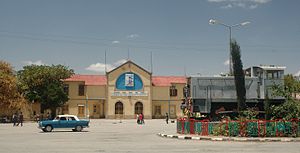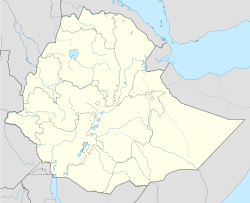
Dire Dawa
Background Information
This Schools selection was originally chosen by SOS Children for schools in the developing world without internet access. It is available as a intranet download. Sponsoring children helps children in the developing world to learn too.
| Dire Dawa ድሬ ዳዋ Dire Dawa |
|
|---|---|
| Railway Station in Dire Dawa | |
|
|
|
| Coordinates: 9°36′N 41°52′E | |
| Country | Ethiopia |
| Region | Dire Dawa |
| Zone | Dire Dawa |
| District | Dire Dawa |
| Government | |
| • Type | Democratic |
| • Mayor | |
| Elevation | 1,708 m (5,604 ft) |
| Population (2008) | |
| • City | 607,321 |
| • Density | 4,530/km2 (11,700/sq mi) |
| • Metro | 1,274,869 |
| Time zone | EAT ( UTC+3) |
| Area code(s) | (251-25) |
Dire Dawa is one of two chartered cities (astedader akabibi) in Ethiopia (the other being the capital, Addis Ababa). This chartered city is divided administratively into two woredas, the city proper and the non-urban woreda of Gurgura.
Dire Dawa lies in the eastern part of the nation, on the Dechatu River, at the foot of a ring of cliffs that has been described as "somewhat like a cluster of tea-leaves in the bottom of a slop-basin." With a latitude and longitude of 9°36′N 41°52′E Coordinates: 9°36′N 41°52′E, this city is the second largest in Ethiopia.
The city is an industrial centre, home to several markets and the Aba Tenna Dejazmach Yilma International Airport. Haramaya University is 40 kilometers away from the city.
History
Dire Dawa was founded in 1902 after the Addis Ababa - Djibouti Railway reached the area. The railroad could not reach the city of Harar at its higher elevation, so Dire Dawa was built nearby. This led to Dire Dawa becoming an important centre of trade between the port of Djibouti and the capital city, Addis Ababa. (Dire Dawa is home to several market centers; the biggest being Taiwan along with Qefira which is located on the flood plain. Near Dire Dawa and what is now Kebele 01, trading happened in the town called Melka Jebdu and in fact, it has been the gateway for most of the goods sold in places such as Taiwan.)
Soon afterwards, Ras Makonnen, the governor of Harar, ordered the construction of a road from Dire Dawa to Harar, one of the first in this part of the country. This road was substantially improved in 1928, improving travel times between the two cities from two days to only a few hours. A generation later, the writer C.F. Rey described the city as the most "advanced" urban centre in the area, with good roads, electric lights and piped water.
In 1931, the Bank of Ethiopia opened its first branch in Dire Dawa.
During the Italian invasion, Mussolini ordered that both Addis Ababa and Dire Dawa would be spared air attacks as a response of demands of the United States and certain European countries for the safety of their citizens. On 6 May 1936 Graziani's units, advancing from Harar, reached the barbed-wire fence at Dire Dawa where they met two French armed cars; the railway was under French administration, and with the departure of Emperor Haile Selassie two days earlier, they remained to protect French interests. The next day, the first train under Italian control left Addis Ababa carrying the 46th Infantry Regiment. The two Italian forces met in Dire Dawa, and the occupation of the town was more or less a formality.
Following the return of Emperor Haile Selassie, Dire Dawa was among the early provincial towns to have its own football league. Around 1947, their Taffari team participated in the Ethiopian Championship series. That same year, the Railroad Workers Syndicate of Dire Dawa, a labor union was formed for welfare purposes. Although its leadership co-operated with the Government, it attempted to strike in 1949 which was brutally suppressed by government troops in 1949; at the time, all strikes were seen by government officials as a form of insurrection.
In 1955 a public address system was installed in the central square, for receiving radio transmissions from the state radio and re-broadcasting them.
The Ethiopian revolution affected the city in many ways. Starting March 1974, there was some unrest of workers; six people were wounded when police opened fire on demonstrating railwaymen and students on 17 April. Many Europeans, Yemeni Arabs and Indians left Dire Dawa; the Greek and Armenian churches were eventually closed due to dwindling membership. On 3 February 1975 the Derg announced that the Cotton Company of Ethiopia was among 14 textile enterprises to be fully nationalized. The cement factory was also later nationalized. In August 1976, the entire leadership of the local branch of the teachers' union was sacked for alleged anti-revolutionary activities. Ten new officials were appointed pending fresh elections.
According to Gebru Tareke, the success of the Ethiopian Army in holding Dire Dawa (17-18 August 1977) against the Somali Army was decisive in winning the Ogaden War.
Dire Dawa was occupied by the EPRDF 31 May 1991. There were reports of about 100 people killed resisting the EPRDF. In 1991, when the Somali National Movement took control of northern Somalia, they dismantled and sold the only publicly owned industry in the whole Somali northern region, a cement factory located near Berbera, which was shipped off to help expand the cement factory in Dire Dawa. Both the Issa and Gurgura Liberation Front and the Oromo Liberation Front claimed the city; as a result, there were numerous clashes between the two groups from 1991 until 1993. This ongoing violence and the fear of protracted ethnic conflict caused the city to be designated federally administered city. Dire Dawa was separated from the Oromia Region around 1998 to become a chartered city.
On June 24, 2002, a small explosive was detonated at the headquarters of the Ethiopian Railway Commission in Dire Dawa. The Oromo Liberation Front (OLF) afterwards claimed responsibility for this attack in retaliation "for the continuing harassment of Oromo students, merchants, and farmers by the Ethiopian government." Although blamed for other isolated incidents, this was the latest bombing inside Ethiopia for which the OLF claimed responsibility.
The city was flooded in August 2006 when the Dechatu River overflowed its banks. About 200 people were reported dead, thousands were displaced and there was extensive damage to homes and markets. Floods are fairly common during the June-September rainy season; over 200 people in the region had been killed by flooding in 2005 that also did millions of dollars in damage.
An overturned truck, heading from Dengego to Dire Dawa, killed a total of 41 people 4 March 2009. The truck was carrying an unknown number of day laborers when the accident happened, and 38 were immediately killed and as many as 50 were injured in the accident. Both dead and injured were taken to Dil-chora Hospital in Dire Dawa. The cause of the accident was not immediately known.
Demographics
Based on the 2007 Census conducted by the Central Statistical Agency of Ethiopia (CSA), Dire Dawa has a total population of 342,827, of whom 171,930 were men and 170,897 women; 232,854 or 67.92% of the population are considered urban inhabitants. With an estimated area of 1,213.20 square kilometers, this chartered city has a population density of 328.06 people per square kilometer. There were 75,693 households in Dire Dawa administrative council with an average of 4.5 persons per household. The major ethnic groups in Dire Dawa include the Oromo (46.08%), Amhara (20.09%), Somali (24.24%), Gurage (4.54%), Harari (1.08%); the remaining 3.97% of the population consists of all other ethnic groups. 70.9% of Dire Dawans are Muslim, 25.6% Orthodox Christian, 2.8% Protestant, 0.4% Catholic, and 0.3% followers of other religions.
In the previous census, conducted in 1994, the city's population was reported to be 251,864, of whom 127,286 were men and 124,578 were women. The percentage of males and females is about 50.5 and 49.5 percent, respectively. The urban residents numbered at the time 173,188 while its rural residents were 78,676. For the entire administrative council there were 52,245 households in Dire Dawa administrative council with an average of 4.7 persons per household. The major ethnic groups included the Oromo (48%), Amhara (27.7%), Somali (13.9%), Gurage (4.5%; 2.3% Sebat Bet, 0.8% Sodo and 1.4% Silt'e); the remaining 5.9% of the population consists of all other ethnic groups. 63.2% of the inhabitants are Muslim, 34.5% Orthodox Christian, 1.5% Protestant, 0.7% Catholic, and 0.1% followers of other religions.
According to the CSA, as of 2004, 90.76% of the total population had access to safe drinking water: 69.61% of rural and 99.48% of urban inhabitants having access. Values for other reported common indicators of the standard of living for Dire Dawa as of 2005 include the following: 11.4% of the inhabitants fall into the lowest wealth quintile; adult literacy for men is 76.6% and for women 53%; and the civic infant mortality rate is 71 infant deaths per 1,000 live births, which is less than the nationwide average of 77; at least half of these deaths occurred in the infants’ first month of life.
Economy
Dire Dawa received postal service in August 1906, becoming the third location after Addis Ababa and Harar. Telephone service was available by 1954; by 1967, Dire Dawa had almost 500 telephone numbers, more than almost all other towns including Gondar, Harar, and Jimma. The CSA estimated in 2005 that farmers in Dire Dawa had a total 40,400 head of cattle (representing 0.1% of Ethiopia's total cattle), 46,280 sheep (0.27%), 118,770 goats (0.92%), 8,820 asses (0.35%), 5,070 camels (1.11%), 44,740 poultry of all species (0.14%), and 840 beehives (less than 0.1%).
The invasive weed Parthenium hysterophorus (or Congress weed) was first observed in Ethiopia near Dire Dawa in 1980. Experts speculate that it entered the country either through the Djibouti - Addis Ababa railway line or the International Airport, carried by one of the various food aid programs.
About 2007, a Concrete sleeper factory was established, sited near the cement factory.
Intercity bus service is provided by the Selam Bus Line Share Company.
Chairmen of the Administrative Council
- Dametew Demissie 1990s
- Solomon Hailu 1990s - 2003
- Fisseha Zerihun 2003 - 2006
- Abdulaziz Mohammed 7 August 2006 - present
(This list is based on information from Worldstatesman.org.)


